To excel in drone racing competitions, start by understanding the rules and safety protocols of each event. Choose a lightweight, high-performance drone, and maintain it regularly for peak performance. Practice consistently to master essential maneuvers and improve your mental toughness. Prepare meticulously for race day, arriving early to set up and familiarize yourself with the venue. Prioritize safety and respect fellow competitors by following etiquette. After each race, analyze your performance to identify areas for improvement. Engaging with the drone racing community can also enhance your skills and broaden your knowledge, paving the way for future success.
Understand Competition Rules
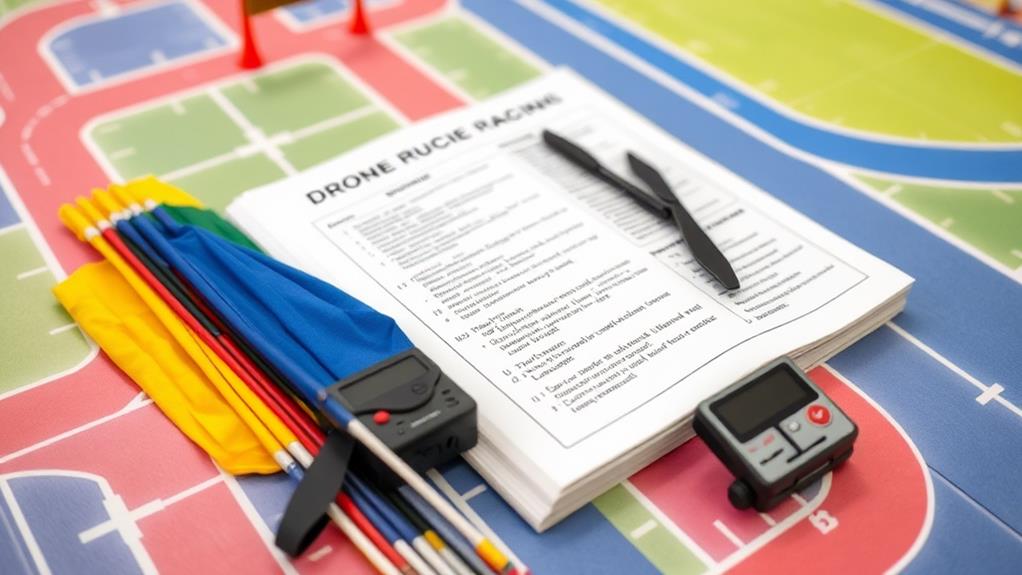
Before you hit the track, it's vital to understand the competition rules of the racing league you're joining, like MultiGP. Each league has specific guidelines that can vary by event and location, so familiarize yourself with them.
Start by reviewing the eligibility requirements for pilots, including age restrictions and necessary documentation or certification needed to compete.
Next, grasp the different race formats, which include qualifying rounds, heats, and finals. The points system determines how winners are identified, so it's important to know how points are awarded throughout the competition.
Equally important are the safety protocols mandated for both pilots and spectators. Make sure you're aware of the required safety gear and conduct pre-race equipment checks to foster a safe racing environment.
Lastly, understand the penalties for rule violations, such as disqualification or time penalties. Knowing these can help you avoid compromising your performance and standing in the competition.
Choose the Right Drone
When you're choosing a racing drone, opting for a lightweight frame is essential, as it boosts your speed and agility on the track.
High-performance motors and batteries are equally important, giving you the power and flight time needed to stay competitive.
Select Lightweight Frame
Choosing a lightweight frame is vital for maximizing your drone's speed and agility during races. A frame that typically weighs between 250 to 350 grams enhances your racing performance, allowing for sharper turns and quicker acceleration.
Opt for materials like carbon fiber or reinforced plastic, as they provide durability without adding unnecessary weight.
When selecting a frame, consider the following features:
- Design for airflow: Make sure your frame promotes efficient airflow, which helps in cooling during intense racing.
- Compatibility with motors: Look for a frame that supports a range of motor sizes and propeller configurations, allowing you to customize your drone based on your racing preferences.
- Easy access to components: Choose a design that provides seamless access to essential components, making repairs or adjustments a breeze.
Additionally, verify that your lightweight frame is compatible with standard FPV equipment. This compatibility guarantees that you can easily integrate cameras, transmitters, and antennas, which are critical for ideal racing performance in competitions.
Making the right choice here can greatly affect your overall success on the track.
High-Performance Components Required
Finding the right drone components is essential for achieving peak performance in racing. Start with lightweight frames crafted from durable materials like carbon fiber. These frames enhance speed and maneuverability, giving you an edge in competitions.
Next, invest in high-performance motors with a KV rating between 2300 to 2700. These motors deliver rapid acceleration and agility, critical for tight turns and fast straights.
Don't overlook the importance of high-capacity LiPo batteries, such as 4S or 6S, with a C-rating of at least 70C. These batteries provide ideal power delivery and extended flight times, ensuring you stay competitive throughout the race.
Additionally, equip your drone with high-quality FPV cameras and low-latency transmitters to maintain a clear and responsive live video feed. This clarity is essential for real-time decision-making during intense races.
Practice Regularly
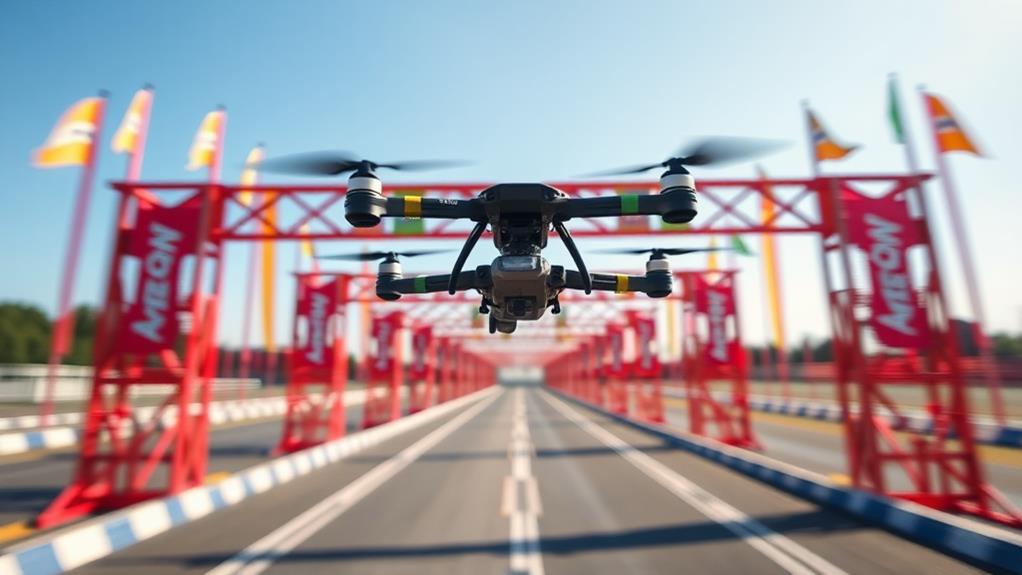
To excel in drone racing, you need to practice regularly and establish a consistent training schedule.
By simulating race conditions during your practice runs, you'll build muscle memory and develop the skills necessary to perform under pressure.
Consistent Training Schedule
Establishing a consistent training schedule is essential for any drone racing pilot looking to improve their skills and performance. Regular, dedicated practice sessions help develop muscle memory, which greatly enhances your piloting skills during races.
Treating these practice sessions like real competitions will help you build good habits and prepare for the pressures you'll face on race day.
To maximize your training effectiveness, consider the following points:
- Engage in skill drills focused on specific maneuvers to improve handling and speed.
- Incorporate mental exercises and self-critique after each session to identify weaknesses and foster a competitive mindset.
- Aim for regular training throughout the racing season to guarantee continuous improvement and adaptability.
Simulate Race Conditions
Simulating race conditions during your practice sessions is essential for honing your drone racing skills. Using flight simulators like Velocidrone or DRL Sim allows you to refine your techniques without risking damage to your equipment.
By creating obstacle courses that mimic actual competition tracks, you can enhance your adaptability and perform under pressure. Incorporating specific maneuvers, such as tight turns and slaloms, is vital for improving your flight precision and speed during real races.
Make sure to analyze your performance by reviewing recorded practice sessions. This performance analysis helps you identify areas for improvement, allowing targeted skill development.
Consistently simulating race environments prepares you for unexpected challenges on race day. The more you practice in these conditions, the more confidence you'll build in your abilities.
Ultimately, by treating your practice sessions like the real thing, you foster a mindset that's ready for competition. Embrace the simulated race conditions as part of your training, and you'll find that you're not just practicing; you're preparing to excel.
This approach not only sharpens your skills but also sets you up for success when it counts the most.
Build Muscle Memory
Practicing regularly is key to building muscle memory, which allows you to execute piloting techniques effortlessly during races. Consistent practice sessions, ideally several times a week, reinforce your muscle memory, making those complex maneuvers second nature.
Engaging in specific drills and exercises, like tight turns and figure eights, can greatly enhance your control over the drone.
Here are some essential tips to incorporate into your practice routine:
- Use FPV simulators to practice in a risk-free environment.
- Incorporate warm-up routines before flights to improve muscle responsiveness.
- Track progress with logs to identify areas needing improvement.
Master Essential Maneuvers
Mastering essential maneuvers is fundamental for any drone racer looking to improve their performance on the track. Start with mastering throttle control, as it's imperative for both acceleration and maneuverability. This skill enables you to navigate tight corners effectively, leading to faster lap times.
Understanding racing lines is equally important; aim for the apex of turns to minimize distance traveled, which enhances your speed.
Practicing specific maneuvers, like tight turns and slaloms, builds muscle memory, allowing for better control during high-speed racing conditions. Familiarizing yourself with visual markers along the racecourse will aid your navigation and timing, helping you shift smoothly between obstacles.
Engaging in regular drills that highlight smooth negotiation of the training course will develop your piloting techniques. These techniques should become second nature, markedly improving your performance.
Analyze Your Performance
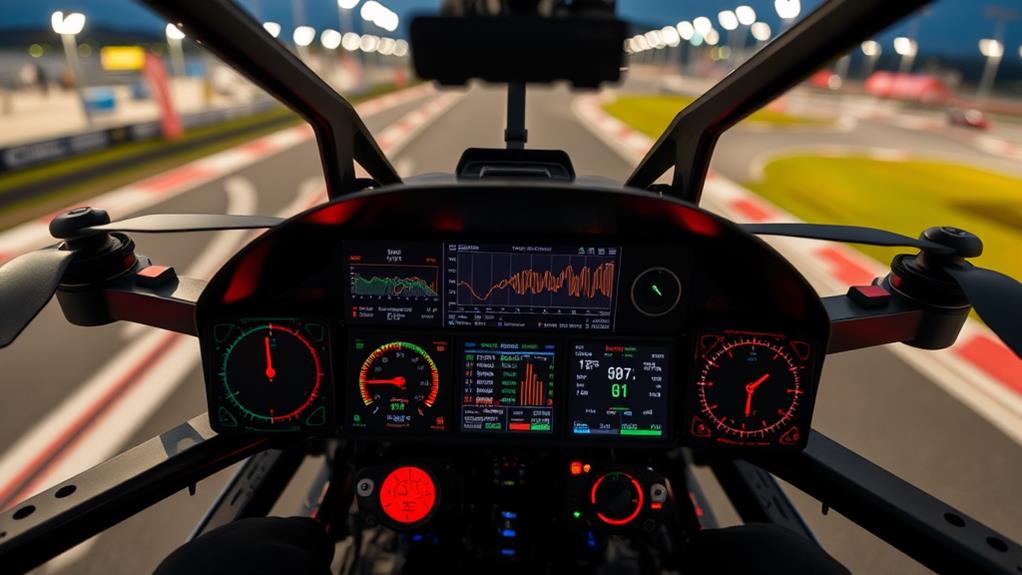
Analyzing your performance is essential for any drone racer aiming to elevate their skills on the track. By conducting a self-critique after each practice session, you'll identify specific areas for improvement, such as inconsistent throttle control or poor racing lines.
Reviewing footage of your flights is invaluable; it allows you to analyze your maneuvers closely, focusing on entry and exit speeds through gates and turns for peak performance.
To improve effectively, consider these points:
- Track Progress: Keep a log of your lap times and performance metrics to monitor improvements over time.
- Adapt Practice Techniques: Concentrate on maneuvers that yield the fastest lap times based on your analysis.
- Build Mental Resilience: Reflect on your racing experiences to manage stress and expectations during competitions.
Connect With the Community
Connecting with the drone racing community is vital for your growth as a pilot.
Joining local clubs and attending community events not only helps you meet fellow racers but also allows you to share knowledge freely, which can speed up your learning.
Join Local Clubs
Joining a local drone racing club can greatly enhance your experience as a pilot. By joining local clubs, you gain access to organized events and hands-on experiences with fellow enthusiasts.
These clubs often affiliate with MultiGP, providing valuable resources, training materials, and competitive racing opportunities tailored to various skill levels. Engaging with club members fosters a supportive environment where you can learn from experienced pilots and improve your skills.
Here are a few benefits of joining a local drone racing club:
- Practice Sessions: Regular practice sessions help you refine your flying techniques and get comfortable with your equipment.
- Community Races: Participating in community races motivates you to push your limits while enjoying friendly competition.
- Camaraderie: Building relationships with other pilots creates a sense of camaraderie that makes the racing experience enjoyable and fulfilling.
Local clubs often facilitate open tryouts, allowing newcomers to compete alongside seasoned racers.
This shift into competitive racing becomes smoother as you share knowledge and experiences, all within a supportive community.
Attend Community Events
When you attend community events organized by local MultiGP chapters, you open the door to invaluable connections with experienced pilots and fellow racing enthusiasts.
These events are excellent opportunities to learn racing techniques and strategies that can elevate your skills. During group practice sessions, you'll engage in healthy competition, pushing each other to improve while fostering camaraderie among racers.
By participating in local racing events, you greatly increase your visibility within the community. This visibility can lead to potential sponsorships, which are essential for advancing your drone racing career.
Furthermore, these events often feature mentorship opportunities, allowing you to learn directly from seasoned pilots. They can provide insights that make maneuvering the complexities of drone racing easier and more enjoyable.
Connecting with others through social media platforms like Facebook and Twitter can also enhance your experience. You can share tips, resources, and experiences, promoting continuous learning and improvement.
Overall, attending community events not only enriches your knowledge but also strengthens your network, paving the way for future success in drone racing.
Embrace these opportunities, and you'll find yourself better prepared for competitions ahead.
Share Knowledge Freely
Sharing knowledge freely within the drone racing community creates a vibrant atmosphere that benefits everyone involved. Engaging with fellow pilots fosters a supportive environment where you can accelerate your learning. By connecting with others, you gain access to invaluable insights and techniques that can enhance your skills.
Consider these key benefits of sharing knowledge:
- Learn from Top Pilots: Access tips and techniques from experienced racers through social media and community resources.
- Join Group Practice Sessions: Engage in healthy competition and motivation while learning from each other's strengths and weaknesses.
- Network for Advanced Techniques: Collaborate with seasoned pilots to discover strategies that can elevate your performance on race day.
The collaborative nature of the drone racing community encourages everyone to celebrate victories, no matter how small. This camaraderie not only strengthens your skills but also fosters friendships that make the sport even more enjoyable.
Develop Mental Toughness
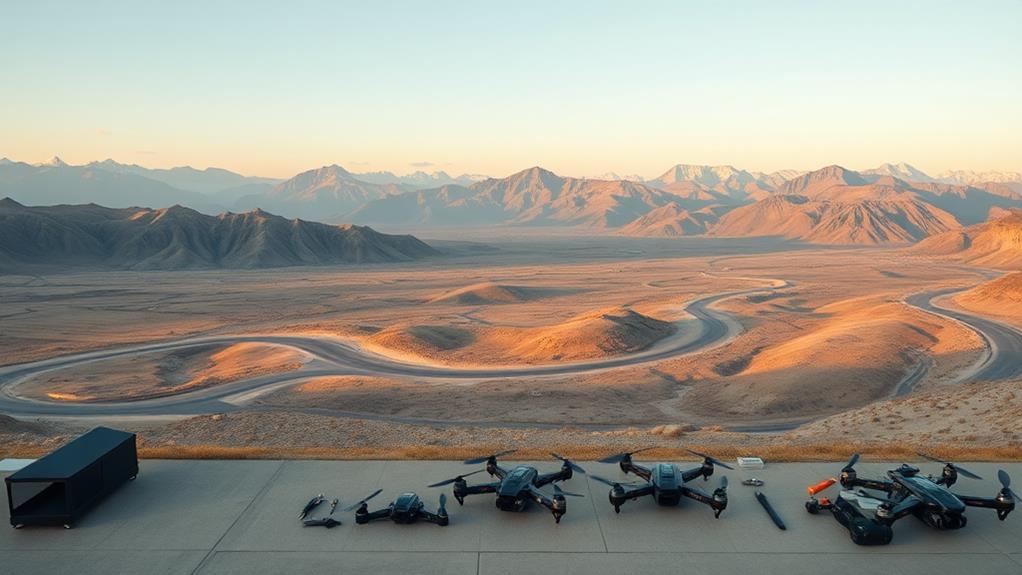
To thrive in the competitive world of drone racing, you must cultivate mental toughness that helps you stay grounded amidst the chaos. The mental game is just as essential as your flying skills. Start by practicing grounding techniques to calm your nerves before flights and enhance your focus during races. This preparation helps you maintain composure in high-pressure moments.
Building confidence through consistent practice is imperative. The more you race, the better you'll manage stress and expectations on the field. After each session, engage in self-critique to identify weaknesses and develop strategies for improvement. This reflective process not only strengthens your skills but also reinforces your mental resilience.
Visualization techniques can further enhance your performance. By mentally rehearsing your maneuvers and race strategies, you'll feel more prepared when it's time to compete.
Focus on maintaining composure during races; a steady mindset allows you to navigate challenges effectively. Remember, mental toughness is about more than just handling pressure; it's about fostering a solid foundation of confidence and clarity.
With dedication, you can develop these essential skills, setting yourself up for success in drone racing competitions.
Maintain Your Equipment
How can you guarantee your drone performs at its best? Maintaining your equipment is vital for peak performance and safety during races. Regular inspections are essential, focusing on critical components like the frame, motors, and propellers to catch any physical damage.
Implement a regular maintenance schedule that includes checking connections, replacing worn parts, and conducting software updates.
To make sure everything runs smoothly, follow these important steps:
- Maintain a stock of essential spare parts, such as propellers, batteries, and motors.
- Conduct pre-race checks to verify battery voltage and confirm all components are functioning properly.
- Clean the lenses of your FPV goggles to guarantee clear visibility while maneuvering obstacles.
Taking these actions will minimize downtime and help you quickly address any issues that may arise during competition.
By prioritizing regular maintenance and thorough pre-race preparations, you'll enhance your drone's reliability and performance.
Prepare for Race Day
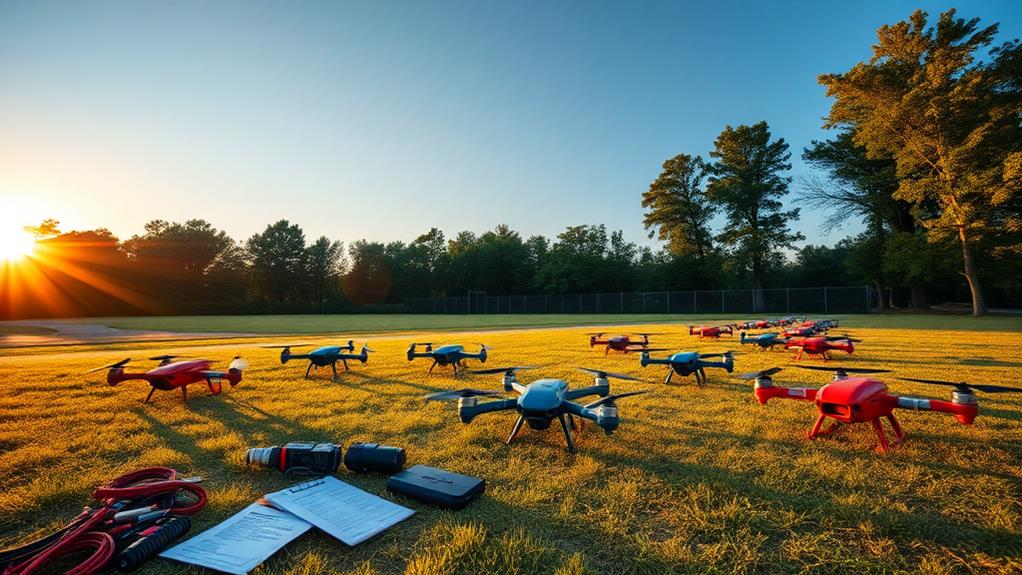
On race day, being well-prepared can make all the difference in your performance. Arrive early at the venue to set up your equipment, familiarize yourself with the race environment, and assist with track preparations. This head start helps you feel more comfortable and in control.
Don't forget to complete the necessary registration paperwork during pilot check-in, which includes paying race fees, receiving channel assignments, and reviewing safety protocols to guarantee compliance with event regulations.
Attending pre-race briefings is vital, as they cover the rules, schedules, and safety protocols essential for a smooth racing experience. Once you're ready, take time to conduct practice laps on the course. This will help you acclimate to the conditions and refine your racing line before the official races begin.
Throughout the day, maintain effective communication with your team members. This collaboration allows you to strategize and provide support, enhancing your overall performance on race day.
Prioritize Safety and Etiquette
While racing drones can be exhilarating, prioritizing safety and etiquette is essential for guaranteeing a positive experience for everyone involved. By following established guidelines, you can help create a safe and enjoyable environment during competitions. Here are three key points to keep in mind:
- Respect local regulations and utilize designated race areas to minimize risks for both participants and spectators.
- Communicate effectively with fellow pilots to coordinate your flight paths, considerably reducing the likelihood of collisions on the racecourse.
- Maintain situational awareness throughout the event, staying vigilant of your surroundings to guarantee safety for all.
Always wear appropriate safety gear, such as goggles, gloves, and helmets, to protect yourself from potential injuries caused by drone crashes or debris.
Understanding and adhering to etiquette enhances the racing experience by fostering a respectful atmosphere among competitors.
Remember, prioritizing safety isn't just about protecting yourself; it's about guaranteeing the well-being of everyone involved in the event.
Conclusion
By following these ten essential tips, you'll set yourself up for success in drone racing competitions. Did you know that competitive drone racing is growing rapidly, with the global market projected to reach over $1 billion by 2025? With dedication and practice, you can elevate your skills and enjoy this thrilling sport. Remember, understanding the rules, maintaining your equipment, and honing your mental toughness are key to excelling on race day. Get ready to take flight!
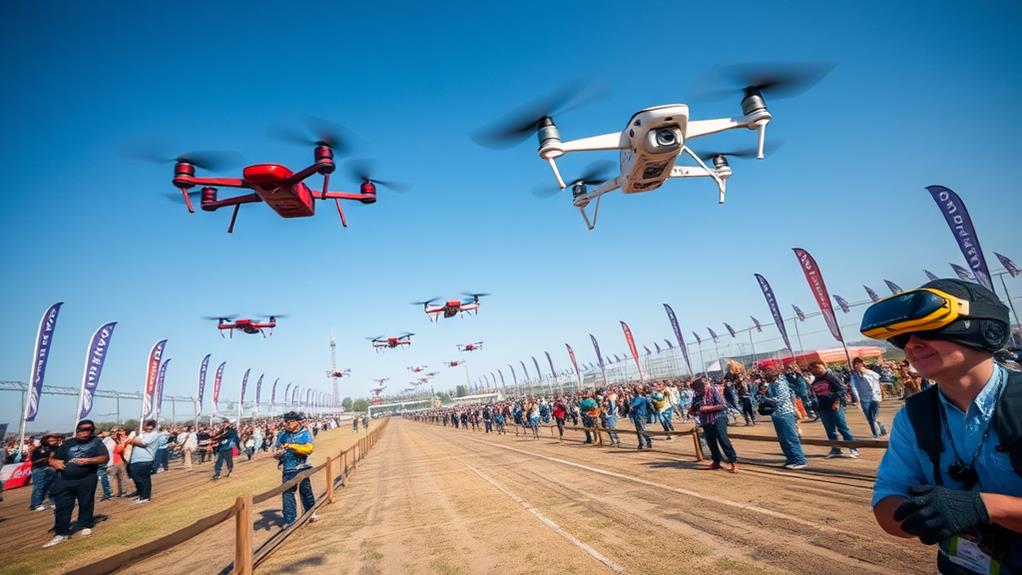
Leave a Reply